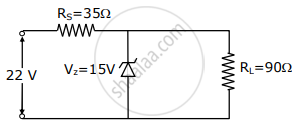Advertisements
Advertisements
प्रश्न
If a small voltage is applied to a p-n junction diode, how will the barrier potential be affected when it is(ii) reveres biased?
उत्तर
If a small voltage is applied to a p–n junction diode in the reverse bias, then the barrier potential increases
APPEARS IN
संबंधित प्रश्न
With what considerations in view, a photodiode is fabricated? State its working with the help of a suitable diagram.
Even though the current in the forward bias is known to be more than in the reverse bias, yet the photodiode works in reverse bias. What is the reason?
Using the necessary circuit diagrams, show how the V-I characteristics of a p-n junction are obtained in
Forward biasing
How are these characteristics made use of in rectification?
The current in the forward bias is known to be more (~mA) than the current in the reverse bias (~μA). What is the reason, then, to operate the photodiode in reverse bias?
Draw the circuit diagram of a full wave rectifier using p-n junction diode.
Explain its working and show the output, input waveforms.
What happens to the width of depletion player of a p-n junction when it is (i) forward biased, (ii) reverse biased?
Explain how a potential barrier is developed in a p-n junction diode.
Answer the following question.
Explain the three processes involved in solar cell working.
For LED's to emit light in visible region of electromagnetic light, it should have energy band gap in the range of:
Briefly explain how emf is generated in a solar cell.
The value of power dissipated across the Zener diode (Vz = 15 V) connected in the circuit as shown in the figure is x × 10–1 watt. The value of x, to the nearest integer, is ______.

